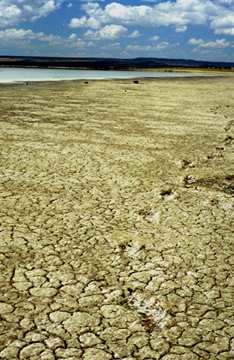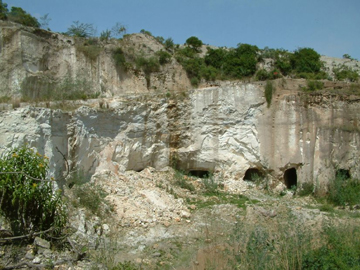Geotimes

Untitled Document

Feature
A Changing Climate
for Human Evolution
Mark Maslin, Martin Trauth and Beth
Christensen
 One
of the defining features of humanity is our need to understand our origins.
We know from the fossil record that our ancestors evolved the abilities to walk
and think in Africa, but our thirst for knowledge means that we not only want
to know where and when, but also how we evolved. To attempt to answer these
huge questions, we need to understand how the landscape in East Africa has changed,
and this is where geologists can make an important contribution to the field
of human evolution.
One
of the defining features of humanity is our need to understand our origins.
We know from the fossil record that our ancestors evolved the abilities to walk
and think in Africa, but our thirst for knowledge means that we not only want
to know where and when, but also how we evolved. To attempt to answer these
huge questions, we need to understand how the landscape in East Africa has changed,
and this is where geologists can make an important contribution to the field
of human evolution.
East Africa’s topography creates
a seasonal climate there, with two relatively short rainy periods and two long
dry periods, which as pictured here, dry out the region’s lake. The switch
between dry and wet periods likely also affected human evolution in the area
thousands of years ago. Courtesy of Martin Trauth.
From the accumulated work of the last two decades, it is clear that East Africa
has one of the most dramatically altered landscapes in recent geological history.
Tectonic movements, climate shifts and changes in the sun’s energy all
influenced the planet over the period of time that humans evolved in Africa.
Each of these processes works at a different timescale, and together they have
produced a unique and highly variable environment. Those environmental changes
could well be responsible for humans walking upright and developing bigger brains.
Moving plates and climate
The scene-setter for the East Africa environment is mountain building both in
Tibet and in East Africa itself. Before the mountains grew, East Africa was
relatively flat with a warm, humid climate probably supporting extensive rainforest,
very similar to Amazonia today. Then, about 50 to 40 million years ago came
the clash of the Indian and Asian continental plates, which from 20 million
years ago to today has caused the massive uplift of the Tibetan plateau.
The building of this 5-kilometer-high plateau deflected weather patterns around
it and thus had a major effect on climate. In summer, the Tibetan plateau also
acts as a huge heat engine, absorbing lots of solar energy, which it transfers
to the atmosphere, causing massive amounts of upward convection. With all this
hot air rising, moist air is sucked in from the Indian Ocean and produces the
intense Southeast Asian monsoons. The process, which continues today, also deflects
moist air away from Africa toward India, progressively drying out East Africa.
In terms of human evolution, this distinct climatic split between Africa and
Asia coincides with the split between Asian and African apes, the latter of
which eventually evolved into us.
At the same time as India collided with Asia, intense volcanism started in East
Africa, and as Tibet thrusted upward, rifting started in Ethiopia. This rifting
initiated in three directions and resulted in the Red Sea, the Gulf of Aden
and the East African Rift. The initial effects of the rifting were small, and
in much of East Africa there was little environmental change for the next 10
million years, while in terms of human evolution, nothing much happened. Even
as late as 6 million years ago, hominin bones of Sahelanthropus tchadensis
with its implied close affinity with gorillas, suggests a relatively mild and
humid climate in Chad, an area that is currently desert.
According to the detailed work of Manfred Strecker at Universität Potsdam
in Germany, from 12 to 1.5 million years ago, the rifting of East Africa moved
from northern Ethiopia southward to Mozambique. This rifting process not only
produced a deep and wide rift valley but also lifted up rift shoulders on either
side, de facto mountain ranges rising up to 4 kilometers high. Interestingly,
since 1.5 million years ago, the rifting process in East Africa has all but
stopped, becoming the dead branch of the triple junction, while rifting remains
active in the Red Sea and Gulf of Aden.
 The effect
of the formation of the Rift Valley on local climate was dramatic. First, the
eastern rift shoulder impeded the moist air from the Indian Ocean from passing
over East Africa, causing the region to dry even further. In fact, the new mountain
range led to the strengthening of the Findlater Jet, the high-altitude, fast-moving
air mass that crosses the equator northward close to East Africa and drags moist
air toward Southeast Asia. That strengthening, in turn, led to an increased
export of moisture to Southeast Asia and an intensification of the monsoons.
The effect
of the formation of the Rift Valley on local climate was dramatic. First, the
eastern rift shoulder impeded the moist air from the Indian Ocean from passing
over East Africa, causing the region to dry even further. In fact, the new mountain
range led to the strengthening of the Findlater Jet, the high-altitude, fast-moving
air mass that crosses the equator northward close to East Africa and drags moist
air toward Southeast Asia. That strengthening, in turn, led to an increased
export of moisture to Southeast Asia and an intensification of the monsoons.
East Africa’s climate is dominated
by two rainy seasons, one long one in April-May and a shorter one in October-November,
which can make fieldwork to study the region’s past more exciting than
usual. Courtesy of Mark Maslin.
Second, the topography of East Africa completely changed from a flat region
covered by rainforest to a landscape with mountains, plateaus and deep rift
valleys with vegetation varying from cloud forest to desert scrub. This incredible
change in the landscape may have caused the evolution of bipedalism — the
ability to walk upright — sometime after 6 million years ago.
Sometimes called the “savannah hypothesis,” the idea is that our need
to walk upright is linked to the replacement of rainforest by grasslands and
the need to travel larger distances between food sources as efficiently as possible.
Anyone who has walked all day can testify to the amazing amount of ground we
can cover. An added advantage of bipedalism, according to Peter Wheeler of Liverpool
John Moores University in the United Kingdom, is that it is easier to maintain
body temperature in the middle of the day, as a smaller area of the body is
exposed when standing upright compared to when on all fours. Calculations suggest
a bipedal hominin would absorb 60 percent less heat in the midday sun than a
hominin in a quadrupedal stance.
Recently, however, some paleoanthropologists have been questioning the savannah
hypothesis, as research sites show that our ancestors, very sensibly, lived
in a mixed environment with both grassland and open forest close to a source
of water. Computer modeling work by Robin Dunbar at University of Liverpool
in the United Kingdom provides a solution to this conundrum, however. He found
that as long as the early hominins spent more than 60 percent of their time
on the ground, they gained a significant benefit from being bipedal, for both
energy efficiency and the ability to run. Despite our views that early bipedal
hominins such as Ardipithecus ramidus or Australopithecus afarensis
were primitive, we should note in fact that they were highly successful, colonizing
at least half a continent, which we know based on remains found as far apart
as South Africa and Ethiopia.
The effects of tectonics on human evolution are not just restricted to Africa
and Asia. Gerald Haug of the GeoForschungsZentrum Potsdam in Germany and colleagues
have shown that thousands of miles away, between 5 and 2 million years ago,
the Panama ocean gateway between North and South America progressively closed.
This sealing stopped the exchange of water between the Pacific and North Atlantic
oceans. Its ultimate effect was to strengthen the Gulf Stream by pumping more
warm water northward, providing the moisture source for the growth of the great
Quaternary ice sheets that kicked off about 2.5 million years ago.
Icy effects
Debate continues concerning the ultimate cause of the great ice ages, but it
seems clear that they were a culmination of a long-term cooling trend that started
more than 10 million years ago and progressed in three major steps. The first
transition was the intensification of northern hemisphere glaciation, about
2.5 million years ago, when for the first time, large ice sheets grew periodically
on North America and Europe. Some of these ice sheets may have been more than
2 kilometers high, and global sea level dropped during the ice ages by as much
as 60 meters.
The second transition is a new discovery by Christina Ravelo and
her team at the University of California at Santa Cruz. They found that about
2 million years ago, the global cooling trend directly affected the tropics
by intensifying the Walker circulation, which is an east-west atmospheric circulation
driven by warm air convection overland and its subsequent sinking. The intensity
of the Walker circulation is linked directly to the intensity of the monsoons
and the occurrence of the El Niño phenomenon.
The final transition was about 1 million years ago, at the Mid-Pleistocene revolution.
Prior to 1 million years ago, ice ages occurred every 41,000 years, but after
then, they became more intense and longer. The ice ages or glacial periods were
the culmination of slow cooling over 80,000 to 90,000 years, resulting in an
ice sheet more than 3 kilometers thick over North America and Europe; so much
water became locked up in the ice sheets that the world’s oceans dropped
in sea level by more than 120 meters. These glacial periods were followed by
short 10,000- to 20,000-year-long interglacial periods, with a climate similar
to the present-day.
So how did these global climate changes affect Africa? Originally, geologists
thought that each one of these climate transitions intensified the drying out
of East Africa. In fact, we know that ice ages are not only cold periods but
also very dry periods of time, an idea known as the “aridity hypothesis,”
which was first suggested by Peter deMenocal of the Lamont-Doherty Earth Observatory
at Columbia University. He showed from dust collected from ocean sediments that
during these climatic transitions, northwest Africa, northeast Africa and Arabia
all became dustier and thus drier.

 Making
the connection to early humans, Rick Potts at the Smithsonian Institution in
Washington, D.C., suggested that early hominins may have evolved bigger brains
during these dry periods as a way of dealing with a highly variable environment.
The fossil record supports this hypothesis, as during these environmental crises,
hominins evolved in two ways: developing bigger brains to think their way out
of trouble, as seen in the skulls of Homo rudolfensis and Homo erectus,
and getting much bigger jaws so they could eat almost anything to survive the
worst droughts, as seen in the jaws of Paranthropus boisei and Paranthropus
robustus.
Making
the connection to early humans, Rick Potts at the Smithsonian Institution in
Washington, D.C., suggested that early hominins may have evolved bigger brains
during these dry periods as a way of dealing with a highly variable environment.
The fossil record supports this hypothesis, as during these environmental crises,
hominins evolved in two ways: developing bigger brains to think their way out
of trouble, as seen in the skulls of Homo rudolfensis and Homo erectus,
and getting much bigger jaws so they could eat almost anything to survive the
worst droughts, as seen in the jaws of Paranthropus boisei and Paranthropus
robustus.
An exposed outcrop of the ancient Lake
Kariandusi shows volcanic fragments that suggest the lake existed between 970,000
and 940,000 years ago. The lake sediments are 35 meters deep and contain diatoms
(inset), which are microfossils of surface dwellers, suggesting that the lake
was several hundred meters deep before drying up at the end of a 20,000-year
cycle. Such cycles may have caused early humans to adapt to climate extremes
with bigger brains and jaws. Images by Martin Trauth.
That connection, however, may be a bit more complicated. Studying lake sediments
in the East African Rift Valley where our ancestors lived, co-authors Martin
Trauth and Mark Maslin, along with colleagues, have found evidence of large
deep lakes during each one of the supposed dry periods. Today, what scientists
do not know is whether humans evolved bigger brains while lounging around beautiful
large lakes or if something more sinister was going on.
There is some tantalizing evidence from lake sediments at Baringo Basin in central
Kenya found by Alan Deino from the Berkeley Geochronology Center that suggests
that these lakes may have come and gone rapidly on a 20,000-year cycle. So our
ancestors may have had an idyllic environment that was cruelly taken away from
them as the lake dried up over a few generations. Thousands of years later,
the lake would return and the cycle would begin again, requiring people to adapt
to survive.
All these dramatic environmental changes are supported by the fossil record
and the development of either big brains or big jaws to deal with intense drought
periods, thus supporting Potts’ variability hypothesis.
Sunny days
The last factor influencing the climate of East Africa is orbital forcing.
The variation of the Earth’s orbit around the sun forces glacial-interglacial
cycles, and recently, geologists have started to appreciate that it also has
an additional separate, but significant, effect on tropical climate.
The most important orbital variable for the tropics is precession (the variation
of Earth’s axis), which influences the amount of sunlight received during
any particular season and has a cycle of about 20,000 years. Modeling work by
Amy Clement of the University of Miami has shown that precession has very little
effect on tropical temperatures, but a huge effect on rainfall. In her models,
changing precession had the same scale of influence on rainfall as shifting
from a glacial to an interglacial period. This link is supported by recent results
from lake deposits and speleothems (mineral formations in caves) in Brazil that
shows that rainfall there is also controlled by a 20,000-year precession cycle.
The same evidence has led Maslin to suggest that this may be the key long-term
repetitive climatic forcing that caused repeated bursts of evolution and thus
the huge biodiversity in Amazonia. Therefore, even if there were no other changes
in the East African environment over the last 10 million years, the amount of
solar radiation received in any particular season could have varied by up to
20 percent, which would have had a significant influence on the timing and duration
of the two wet seasons.
This precessional forcing of the East African climate is supported by tentative
data from the lake studies by Deino, who has evidence of the appearance and
disappearance of the deposition of lake sediments every 20,000 years. Moreover,
the variable topography and global climate changes may have enhanced the sensitivity
of East Africa to the precessional effects of seasons, thus impacting the rainfall
of the region. This process would have had an important effect on human evolution,
as the survival of any hominin is dependent on access to water.
Evolving forward
Geologists have started to put together a coherent picture of how the environment
of East Africa has changed over the last 10 million years. The region has changed
beyond all recognition over this period of time: from a relatively flat homogeneous
region covered with rainforest, to a spectacularly heterogeneous region with
mountains more than 4 kilometers high and vegetation ranging from desert scrub
to dense forest. Add to the mix major global cooling, dramatic intensification
of tropical atmospheric circulation, and regular 20,000-year variations in rainfall,
and it could have been a dynamic system for human evolutionary development.
We still do not know, however, how quickly these environmental changes occurred
— over centuries or decades, and whether they were fast enough to cause
evolution. Also, we need to understand whether these changes were synchronous
across eastern and southern Africa. Maslin and Trauth hope to address that first
key question by dating the retreat of the large Rift Valley lakes that we know
existed at the beginning of our current interglacial some 10,000 years ago.
Preliminary evidence suggests that more than 1,000 square miles of lakes vanished
in a very short period of time. As to the synchronicity of pan-African climatic
changes, co-author Beth Christensen and Maslin hope to compare marine records
of southwestern Africa’s climate with those that already exist for East
Africa. Both of these studies, along with work from others, hopefully will help
us untangle the complex and highly variable climate of Africa.
In many ways, with all this dramatic environmental change occurring in East
Africa, it is not surprising it was a hotbed of evolution, producing an ape
that not only can walk upright but can even ponder its own evolution.
Maslin is an associate professor
with the Environmental Change Research Centre at the University College London
in the United Kingdom. Trauth is an associate professor with the Institut für
Geowissenschaften at the Universität Potsdam in Germany. And Christensen
is an assistant professor at the Environmental Studies Program at Adelphi University
in Garden City, N.Y.
Back to top
Untitled Document

 One
of the defining features of humanity is our need to understand our origins.
We know from the fossil record that our ancestors evolved the abilities to walk
and think in Africa, but our thirst for knowledge means that we not only want
to know where and when, but also how we evolved. To attempt to answer these
huge questions, we need to understand how the landscape in East Africa has changed,
and this is where geologists can make an important contribution to the field
of human evolution.
One
of the defining features of humanity is our need to understand our origins.
We know from the fossil record that our ancestors evolved the abilities to walk
and think in Africa, but our thirst for knowledge means that we not only want
to know where and when, but also how we evolved. To attempt to answer these
huge questions, we need to understand how the landscape in East Africa has changed,
and this is where geologists can make an important contribution to the field
of human evolution. 
 The effect
of the formation of the Rift Valley on local climate was dramatic. First, the
eastern rift shoulder impeded the moist air from the Indian Ocean from passing
over East Africa, causing the region to dry even further. In fact, the new mountain
range led to the strengthening of the Findlater Jet, the high-altitude, fast-moving
air mass that crosses the equator northward close to East Africa and drags moist
air toward Southeast Asia. That strengthening, in turn, led to an increased
export of moisture to Southeast Asia and an intensification of the monsoons.
The effect
of the formation of the Rift Valley on local climate was dramatic. First, the
eastern rift shoulder impeded the moist air from the Indian Ocean from passing
over East Africa, causing the region to dry even further. In fact, the new mountain
range led to the strengthening of the Findlater Jet, the high-altitude, fast-moving
air mass that crosses the equator northward close to East Africa and drags moist
air toward Southeast Asia. That strengthening, in turn, led to an increased
export of moisture to Southeast Asia and an intensification of the monsoons.
 Making
the connection to early humans, Rick Potts at the Smithsonian Institution in
Washington, D.C., suggested that early hominins may have evolved bigger brains
during these dry periods as a way of dealing with a highly variable environment.
The fossil record supports this hypothesis, as during these environmental crises,
hominins evolved in two ways: developing bigger brains to think their way out
of trouble, as seen in the skulls of Homo rudolfensis and Homo erectus,
and getting much bigger jaws so they could eat almost anything to survive the
worst droughts, as seen in the jaws of Paranthropus boisei and Paranthropus
robustus.
Making
the connection to early humans, Rick Potts at the Smithsonian Institution in
Washington, D.C., suggested that early hominins may have evolved bigger brains
during these dry periods as a way of dealing with a highly variable environment.
The fossil record supports this hypothesis, as during these environmental crises,
hominins evolved in two ways: developing bigger brains to think their way out
of trouble, as seen in the skulls of Homo rudolfensis and Homo erectus,
and getting much bigger jaws so they could eat almost anything to survive the
worst droughts, as seen in the jaws of Paranthropus boisei and Paranthropus
robustus.